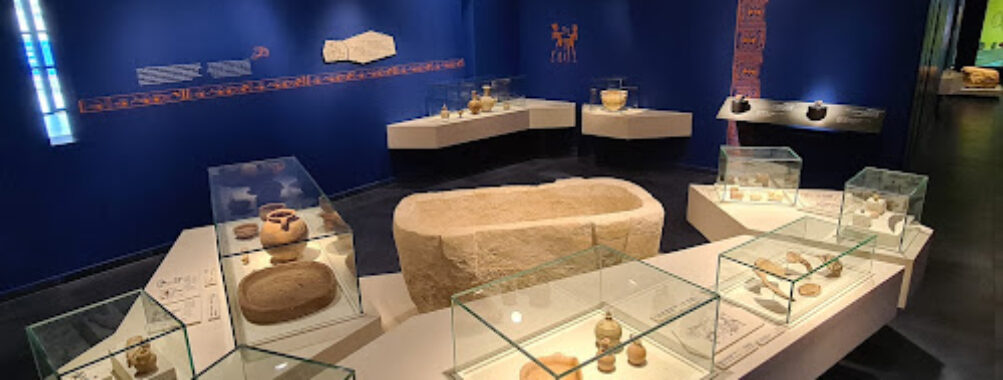
Museum of Philistine Culture
“`html
Table of Contents
Description
The Museum of Philistine Culture in Ashdod is one of those places that sneaks up on you. At first glance, it looks like just another regional museum, but once inside, you realize it’s far more than that. This is the only museum in the world dedicated entirely to the Philistines, an ancient people who lived along the Mediterranean coast thousands of years ago. And it doesn’t just show artifacts behind glass—it tries to pull you into their world with pottery, jewelry, tools, and even immersive experiences like a traditional Philistine feast. That’s the kind of detail that makes history feel alive instead of stuck in a textbook.
The atmosphere is fairly relaxed and approachable. Some exhibits are straightforward, showing you finely crafted pottery or delicate jewelry. Others are more interactive, designed to make you feel like you’re stepping into the daily life of the Philistines. It’s not a massive museum, so you won’t get lost wandering endless halls, but it’s packed with enough detail to keep you curious. Families often find it manageable—kids can get a kick out of the hands-on parts—and adults tend to appreciate the depth of history that’s presented without being overwhelming.
Of course, not every visitor walks away equally impressed. Some people expect a larger, flashier attraction, and if you’re looking for something on the scale of the Louvre, you’ll likely feel underwhelmed. But for travelers who enjoy archaeology, or who just like to dig a little deeper into the cultures that shaped the region, it’s a rewarding stop. Personally, I love that it feels authentic and not overly polished. It’s the kind of place where you can slow down, actually read the descriptions, and walk away knowing something you didn’t before.
Key Features
- Exclusive focus on Philistine culture, the only museum of its kind worldwide
- Displays of pottery, jewelry, and everyday artifacts from thousands of years ago
- Interactive experiences, including the option to join a traditional Philistine feast
- Family-friendly exhibits that keep kids engaged without overwhelming them
- Accessibility features such as wheelchair-accessible entrance, restrooms, and parking
- Modern amenities like clean restrooms, though no on-site restaurant
Best Time to Visit
If you’re planning a trip, late spring and early autumn tend to be the sweet spots. The weather in Ashdod is warm but not scorching, which makes the entire outing more enjoyable. During the summer, the heat can make you want to rush through, and in winter, while the museum itself is indoors, the surrounding area feels less inviting. Weekdays are generally quieter, giving you more time to linger at the exhibits without feeling rushed. I once went on a Tuesday morning and basically had the place to myself—it made the whole experience feel more personal. Weekends, on the other hand, can get busier with families and school groups.
How to Get There
Reaching the museum is pretty straightforward if you’re already in Israel. Ashdod is well connected by road, and if you’re driving, there’s accessible parking available. Public transportation is also an option—buses run regularly from nearby cities, and the ride itself gives you a glimpse of the coastal landscape. If you’re coming from Tel Aviv, it’s not a long journey, just under an hour depending on traffic. Honestly, I’d recommend taking the bus if you don’t want the hassle of parking, but if you like the flexibility of stopping along the way, driving is the way to go.
Tips for Visiting
First off, give yourself at least a couple of hours. While the museum isn’t huge, you’ll want time to really dive into the exhibits rather than just glance at them. Bring a bottle of water with you, especially if you’re visiting in the warmer months, since there’s no on-site café or restaurant. If you’re traveling with kids, plan ahead for breaks—the museum is good for children, but younger ones may need a little distraction between sections.
Another tip: don’t skip the interactive experiences. The Philistine feast, for example, is quirky and fun, and it’s one of those things you’ll remember long after you’ve forgotten the names of specific artifacts. Also, check the schedule before you go. Sometimes there are temporary exhibitions or special events that add an extra layer to the visit. And if you’re someone who likes to avoid crowds, aim for mid-morning on a weekday. That’s when the museum feels most peaceful, and you can take your time without juggling around groups.
Lastly, keep an open mind. Some people arrive expecting grand architecture or vast collections, but what makes this museum special is its focus. It’s not trying to be everything—it’s trying to tell the story of one culture, and it does that well. If you approach it with curiosity, you’ll walk away with a richer sense of the past and maybe even a new appreciation for how much history can be packed into a single city.
“`
Location
Places to Stay Near Museum of Philistine Culture
Find and Book a Tour
Explore More Travel Guides
No reviews found! Be the first to review!